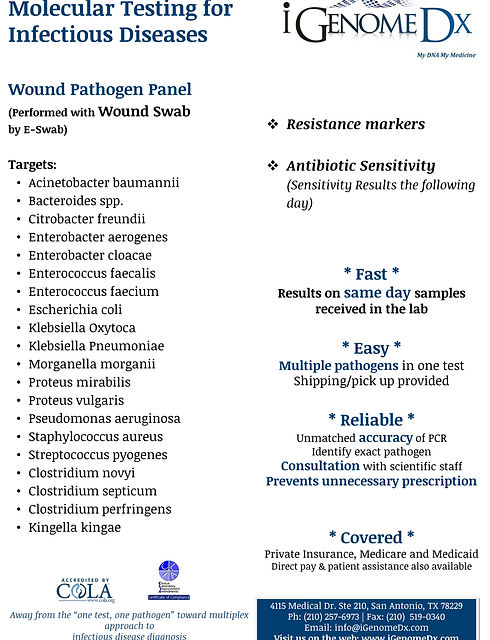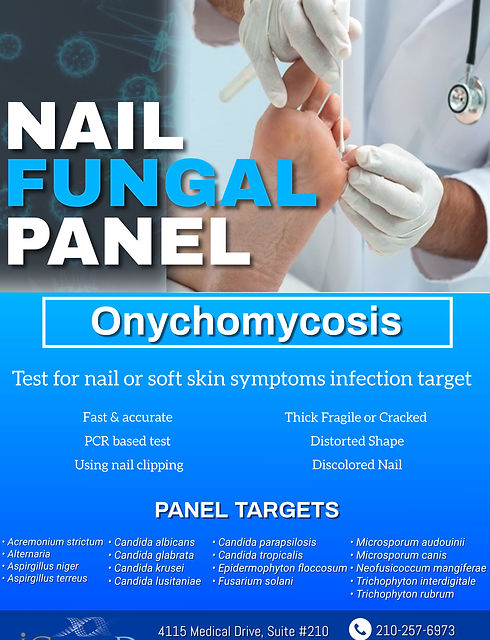
INFECTIOUS DISEASE
DNA-based Infectious Disease Detection
BACKGROUND
iGenomeDx provides a faster and more accurate method to detect infectious agents. A simple swab-based test is used to identify commonly occurring infectious agents including bacteria and viruses. This test is of utmost importance in pediatric care and hospital-acquired infection detection. Often it is difficult to distinguish the agent of infection: bacterial or viral. Bacterial infections can be treated using antibiotics whereas few treatment options exist for viral infection. Incorrect diagnoses may lead to an unnecessary medication regimen which should be most definitely avoided.
SCIENCE
A unique DNA fragment (primer) of each pathogen is used to uniquely identify the presence of respective DNA which in turn confirms the presence/absence of the pathogen. This primer-based method uniquely identifies the pathogen giving the most accurate diagnostic of the infectious disease.
BENEFITS OF TESTING VIA DNA-BASED METHOD
-
Accuracy. Can identify a specific pathogen or at a minimum, distinguish between bacterial and viral infections
-
Rapid Diagnostic. DNA-based method can test the patient specimen for multiple pathogens with much faster speed than culture based methodology traditionally used in the current clinical setting.
-
Avoid Unnecessary Medication. Pediatric Care is often striving to reduce the use of undesirable medication for children.
-
Hospital-Acquired Infection. Often infections acquired due to hospital stays are detected 48 hours after being discharged. The suggested DNA test on discharge may help with the early detection of certain hospital-acquired infections. This may reduce the discomfort caused to the patient and help improve the performance and ratings of the hospital.
Infectious Disease Test Profiles
Respiratory

Pathogens Tested
VIRUS TARGETS
-
SARS-CoV-2 (COVID-19)
Influenza
-
Influenza (A, H1-2009)
-
Influenza B
-
Influenza C
-
Parainfluenza (1, 2, 3 & 4)
Common Cold
-
Adenovirus
-
Human bocavirus
-
Human rhinovirus
-
Human coronavirus (NL63/229E/OC43/HKU1)
-
Enterovirus
-
Human parechovirus
Respiratory Syncytial viruses A/B
Metapneumovirus A/B
BACTERIA TARGETS
Pneumonia
-
Chlamydia pneumoniae
-
Mycoplasma pneumoniae
-
Staphylococcus aureus
-
Streptococcus pneumoniae
-
Haemophilus influenzae/Type B
-
Klebsiella pneumoniae
-
Legionella pneumophila/ longbeachae
Moraxella catarrhalis
Whooping Cough
-
Bordetella sp. (except B. parapertusis)
FUNGAL TARGET
-
Pneumocystis jirovecii
UTI

Pathogens Tested
-
Escherichia coli
-
Staphylococcus aureus
-
Streptococcus saprophyticus
-
Enterococcus faecalis
-
Ureaplasma urealyticum
-
Candida sp.
-
Proteus mirabilis
-
Klebsiella pnuemoniae
-
Morganella morganii
-
Serratia marcescens
-
Mycoplasma hominis
-
Klebsiella oxytoca
-
Enterobacter cloacae
-
Providencia stuartii
-
Pseudomonas aeruginosa
-
Streptococcus agalactiae
Resistance Markers
STI

Pathogens Tested
-
Chlamydia trachomatis
-
Gardnerella vaginalis
-
Mycoplasma genitalium
-
Neisseria gonorrhoeae
-
Treponema pallidum
-
Trichomonas vaginalis
-
Herpes simplex virus 1
-
Herpes simplex virus 2
-
Ureaplasma parvum / urealyticum
Gastro

Pathogens Tested
VIRUS TARGETS
-
Adenovirus
-
Astrovirus
-
Norovirus G1
-
Norovirus G2
-
Rotavirus
-
Sapovirus
BACTERIA TARGETS
-
Campylobacter sp.
-
Clostridium difficile
-
Salmonella sp.
-
Shigella sp.
-
Verotoxin positive E. coli
-
Yersinia enterocolitica
PARASITES
-
Cryptosporidium sp.
-
Entamoeba histolytica
-
Giardia lamblia
Wound

Pathogens Tested
-
Acinetobacter baumannii
-
Bacteroides spp
-
Citrobacter freundii
-
Enterobacter aerogenes
-
Enterobacter cloacae
-
Enterococcus faecalis
-
Streptococcus pyogenes
-
Enterococcus faecium
-
Escherichia coli
-
Klebsiella oxytoca
-
Klebsiella pneumoniae
-
Morganella morganii
-
Proteus mirabilis
-
Proteus vulgaris
-
Pseudomonas aeruginosa
-
Staphylococcus aureus
-
Clostridium novy
-
Clostridium septicum
-
Clostridium perfringens
-
Kingella kingae
Nail Fungal
(Onychomycosis)

Pathogens Tested
-
Acremonium strictum
-
Alternaria
-
Aspergillus niger
-
Aspergillus terreus
-
Candida albicans
-
Candida glabrata
-
Candida krusei
-
Candida lusitaniae
-
Candida parapsilosis
-
Candida tropicalis
-
Epidermophyton floccosum
-
Fusarium solani
-
Microsporum audouinii
-
Microsporum canis
-
Neofusicoccum mangiferae
-
Trichophyton interdigitale
-
Trichophyton rubrum
